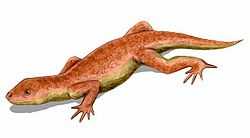Parareptilia
| Parareptiles Temporal range: Possible descendant taxon Testudines survives to Present | |
|---|---|
 | |
| Skeleton of the parareptile Bradysaurus baini | |
| Scientific classification | |
| Kingdom: | Animalia |
| Phylum: | Chordata |
| Class: | Reptilia |
| Clade: | Sauropsida |
| Stem: | †Parareptilia Olson, 1947 |
| Orders | |
|
Mesosauria and see cladograms below | |
Parareptilia ("at the side of reptiles") is a subclass or clade of reptiles which is variously defined as an extinct group of primitive anapsids, or a more cladistically correct alternative to Anapsida. Whether the term is valid depends on the phylogenetic position of turtles, the relationships of which to other reptilian groups are still uncertain.
The name Parareptilia was coined by Olson in 1947 to refer to an extinct group of Paleozoic reptiles, as opposed to the rest of the reptiles or Eureptilia ("true reptiles").

The name fell into disuse until it was revived by cladistic studies, to refer to anapsids that were thought unrelated to turtles. Gauthier et al. 1988 provided the first phylogenetic definitions for the names of many amniote taxa, including Sauropsida as the parent clade for Reptilia, and argued cladistically that captorhinids and turtles were sister groups, constituting the clade Anapsida (in a much more limited context than the definition given by Romer in 1967). A name had to be found for various Permian and Triassic reptiles no longer included in the anapsids, and "parareptiles" was chosen. However, they did not feel confident enough to erect Parareptilia as a formal taxon. Their cladogram was as follows:
| AMNIOTA |
| |||||||||||||||||||||||||||||||||||||||||||||||||||
| |
Laurin and Reisz 1995 presented a different cladogram, in which Reptilia is divided into Parareptilia (now a formal taxon) and Eureptilia. Captorhinidae is transferred to Eureptilia, and Parareptilia includes both early anapsid reptiles and turtles, but not Captorhinidae and Protorothyrididae. The mesosaurs are placed outside both groups, as the sister taxon to the reptiles (but still sauropsids). The traditional taxon of Anapsida is rejected as paraphyletic. This gives the following:
| AMNIOTA |
| |||||||||||||||||||||||||||||||||||||||||||||||||||
| |
In contrast, Rieppel, 1994, 1995; Rieppel & deBraga, 1996; and deBraga & Rieppel, 1997 have argued that turtles are actually related to Sauropterygia, and hence are diapsids. The diapsid affinities of turtles have been supported by molecular phylogenies (e.g. Zardoya and Meyer 1998; Iwabe et al., 2004; Roos et al., 2007; Katsu et al., 2010). This would make Parareptilia a wholly extinct clade. However this hypothesis has not been accepted by all vertebrate paleontologists, and Benton 2000, 2004, retained the traditional class Anapsida for the "parareptiles" and turtles.
See also
- Anapsida
References
- Benton, M. J. (2000). Vertebrate Palaeontology (2nd ed.). London: Blackwell Science Ltd. ISBN 0-632-05614-2., 3rd ed. 2004 ISBN 0-632-05637-1
- deBraga, M.; Rieppel, O. (1997). "Reptile phylogeny and the interrelationships of turtles". Zoological Journal of the Linnean Society 120 (3): 281–354. doi:10.1006/zjls.1997.0079.
- deBraga, M.; Reisz, R. R. (1996). "The Early Permian reptile Acleistorhinus pteroticus and its phylogenetic position". Journal of Vertebrate Paleontology 16 (3): 384–395. doi:10.1080/02724634.1996.10011328.
- Gauthier, J.; A. G. Kluge, & T. Rowe (1988). "The early evolution of the Amniota". In M. J. Benton (ed.). The phylogeny and classification of the tetrapods, Volume 1: amphibians, reptiles, birds. 103-155. Oxford: Clarendon Press.
- Iwabe, N.; Hara, Y.; Kumazawa, Y.; Shibamoto, K.; Saito, Y.; Miyata, T.; Katoh, K. (2004-12-29). "Sister group relationship of turtles to the bird-crocodilian clade revealed by nuclear DNA-coded proteins". Molecular Biology and Evolution 22 (4): 810–813. doi:10.1093/molbev/msi075. PMID 15625185. Retrieved 2010-12-31.
- Katsu, Y.; Braun, E. L.; Guillette, L. J. Jr.; Iguchi, T. (2010-03-17). "From reptilian phylogenomics to reptilian genomes: analyses of c-Jun and DJ-1 proto-oncogenes". Cytogenetic and Genome Research 127 (2–4): 79–93. doi:10.1159/000297715. PMID 20234127.
- Laurin, M.; Gauthier, J. A. (1996). "Phylogeny and Classification of Amniotes". at the Tree of Life Web Project.
- Laurin, M.; Reisz, R. R. (1995). "A reevaluation of early amniote phylogeny". Zoological Journal of the Linnean Society 113 (2): 165–223. doi:10.1111/j.1096-3642.1995.tb00932.x. (abstract)
- Olson, E. C. (1947). "The family Diadectidae and its bearing on the classification of reptiles". Fieldiana Geology 11: 1–53. ISSN 0096-2651.
- Rieppel, O. (1994). "Osteology of Simosaurus gaillardoti and the relationships of stem-group sauropterygia". Fieldiana Geology 1462: 1–85. ISSN 0096-2651.
- Rieppel, O. (1995). "Studies on skeleton formation in reptiles: implications for turtle relationships". Zoology-Analysis of Complex Systems 98: 298–308.
- Rieppel, O.; deBraga, M. (1996). "Turtles as diapsid reptiles". Nature 384 (6608): 453–455. doi:10.1038/384453a0.
- Romer, A. S. (1967). Vertebrate Paleontology (3rd ed.). Chicago: University of Chicago Press. ISBN 0-7167-1822-7.
- Roos, Jonas; Aggarwal, Ramesh K.; Janke, Axel (Nov 2007). "Extended mitogenomic phylogenetic analyses yield new insight into crocodylian evolution and their survival of the Cretaceous–Tertiary boundary". Molecular Phylogenetics and Evolution 45 (2): 663–673. doi:10.1016/j.ympev.2007.06.018. PMID 17719245.
- Zardoya, R.; Meyer, A. (1998). "Complete mitochondrial genome suggests diapsid affinities of turtles". Proc Natl Acad Sci U S A 95 (24): 14226–14231. doi:10.1073/pnas.95.24.14226. ISSN 0027-8424. PMC 24355. PMID 9826682.
External links
- Parareptilia
- re Reptilian Subclass Parareptilia? - Dinosaur Mailing List archives
| |||||||||||||||||||||||||||||||||||||||||||||||||||||||||||||||||||||||||||||||||||||||||||||||||||||||||||||||||||||||||||